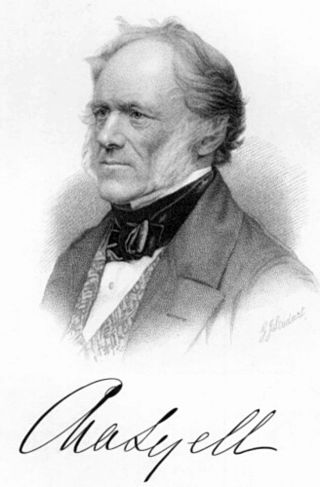
Sir Charles Lyell, 1st Baronet, was a Scottish geologist who demonstrated the power of known natural causes in explaining the earth's history. He is best known today for his association with Charles Darwin and as the author of Principles of Geology (1830–33), which presented to a wide public audience the idea that the earth was shaped by the same natural processes still in operation today, operating at similar intensities. The philosopher William Whewell dubbed this gradualistic view "uniformitarianism" and contrasted it with catastrophism, which had been championed by Georges Cuvier and was better accepted in Europe. The combination of evidence and eloquence in Principles convinced a wide range of readers of the significance of "deep time" for understanding the earth and environment.

Georg Heinrich Pertz was a German historian.

Henry Mackenzie FRSE was a Scottish lawyer, novelist and writer sometimes seen as the Addison of the North. While remembered mostly as an author, his main income came from legal roles, which led in 1804–1831 to a lucrative post as Comptroller of Taxes for Scotland, whose possession allowing him to follow his interest in writing.

Cecilia Payne-Gaposchkin was a British-American astronomer and astrophysicist. In her 1925 doctoral thesis she proposed that stars were composed primarily of hydrogen and helium. Her groundbreaking conclusion was initially rejected, because it contradicted the science of the time, which held that no significant elemental differences distinguished the Sun and Earth. Independent observations eventually proved that she was correct. Her work on the nature of variable stars was foundational to modern astrophysics.

Sir James Hall of Dunglass, 4th Baronet FRS FRSE was a Scottish geologist and geophysicist. He was a Member of Parliament for St. Michael's borough 1807–1812.
Matthew Forster Heddle FRSE was a Scottish physician and amateur mineralogist active through the 19th century.

James Nicol FRSE FGS was a Scottish geologist.

George Douglas, 16th Earl of Morton, KT, FRS, FRSE, FSA was a Scottish peer and politician.
Richard de Morville, Lord of Cunninghame succeeded his father, Hugh de Morville, as Constable of Scotland and in his Scottish estates and English lands at Bozeat in Northamptonshire, and Rutland, as well as a number of feus of the Honour of Huntingdon.
William Schaw was Master of Works to James VI of Scotland for building castles and palaces, and is claimed to have been an important figure in the development of Freemasonry in Scotland.

Ramsay Heatley Traquair FRSE FRS was a Scottish naturalist and palaeontologist who became a leading expert on fossil fish.
Edward John Payne was an English barrister and historian specializing in colonial history.

Mary Horner Lyell was a conchologist and geologist. She was married to the famed British geologist Charles Lyell and assisted him in his scientific work as his Interpreter, Scribe and Assistant Researcher. She never became widely known in her own right, although it is believed by historians that she likely made major contributions to her husband's work. Her own known independent work includes her studies in the Canary Islands, in which she studied land snails in 1854.
Sir Frederick Henry Stewart was a Scottish geologist and academic who was a professor at the University of Edinburgh.
Dorothea Frances Matilda Pertz FLS was a British botanist. She co-authored five papers with Francis Darwin, Charles Darwin's son. She was made a Fellow of the Linnean Society, among the first women admitted to full membership.
Sir John Rose Cormack was a Scottish physician and medical journalist. He established several notable British journals: the Edinburgh Monthly Journal of Medical Science; the London Medical Journal; and the Associated Medical Journal.

Charles Findlay Davidson OBE FRSE FGS MIMM was a Scottish geologist. He served as Vice President of the Royal Society of Edinburgh. He was Assistant Curator to the Museum of Practical Geology in London and Chief Geologist of the British Geological Survey.
William Thomas Gordon FRSE FGS FGSE FLS FGA (1884–1950) was a Scottish palaeontologist and palaeobotanist in the early 20th century. He was also an expert on diamonds and gemstones and assisted Hatton Garden in the testing of rare stones.
William Quarrier Kennedy FRS FRSE FGS was a Scottish geologist. He specialised in the geology of Scotland and Africa. In authorship he is usually referred to as W. Q. Kennedy.

James Burnes was a Scottish doctor and surgeon in India, who became physician-general of Bombay.












